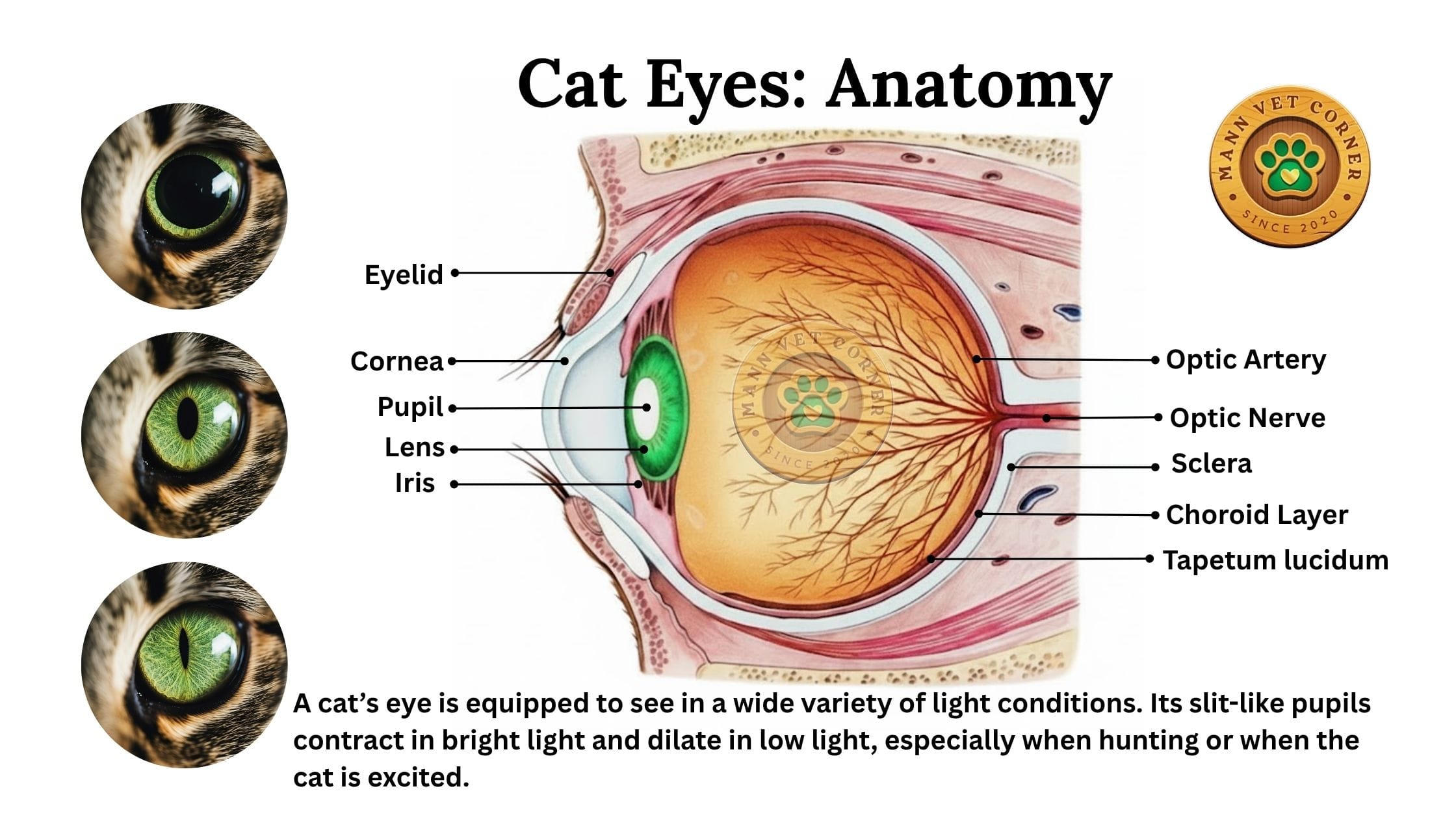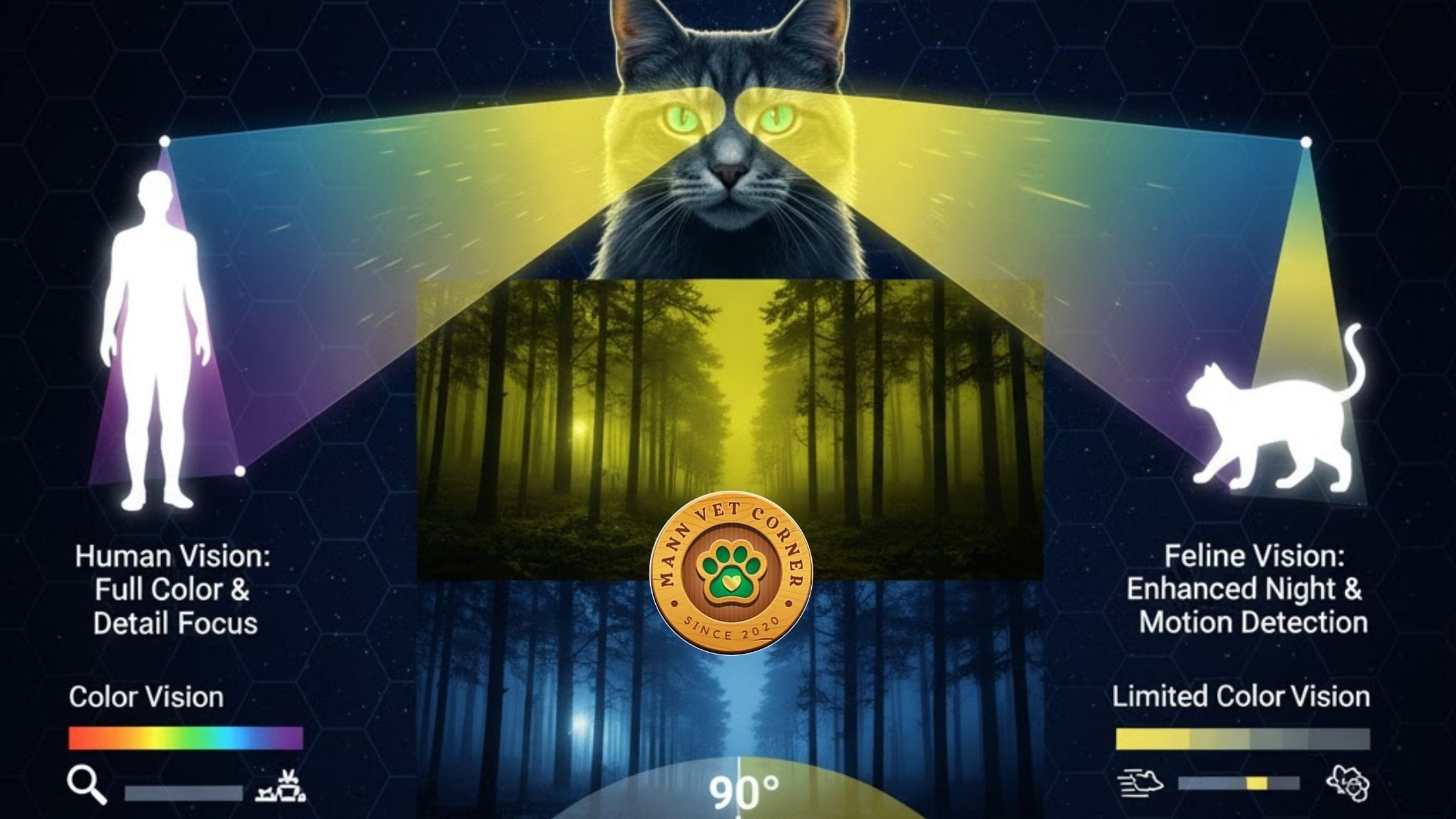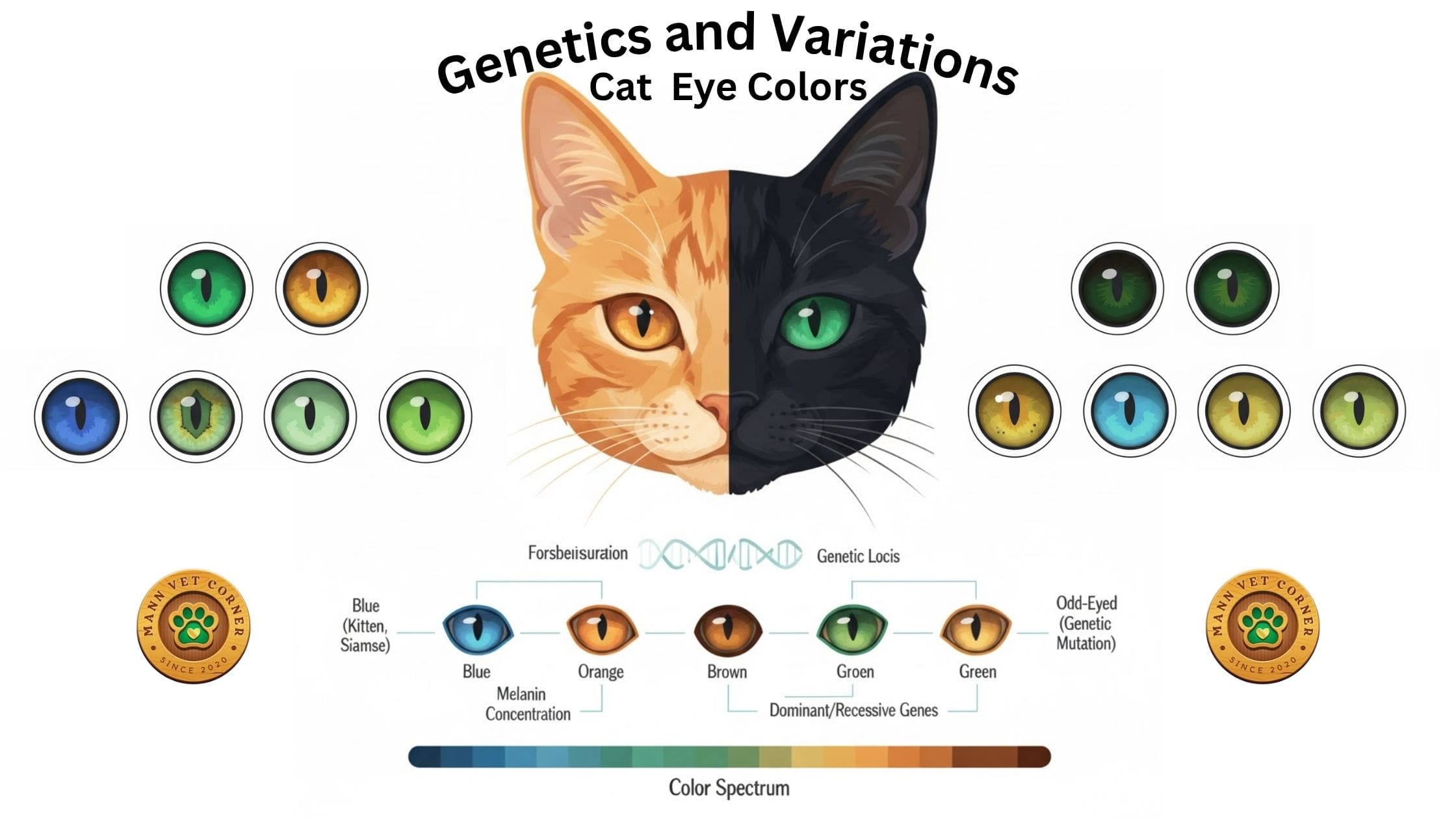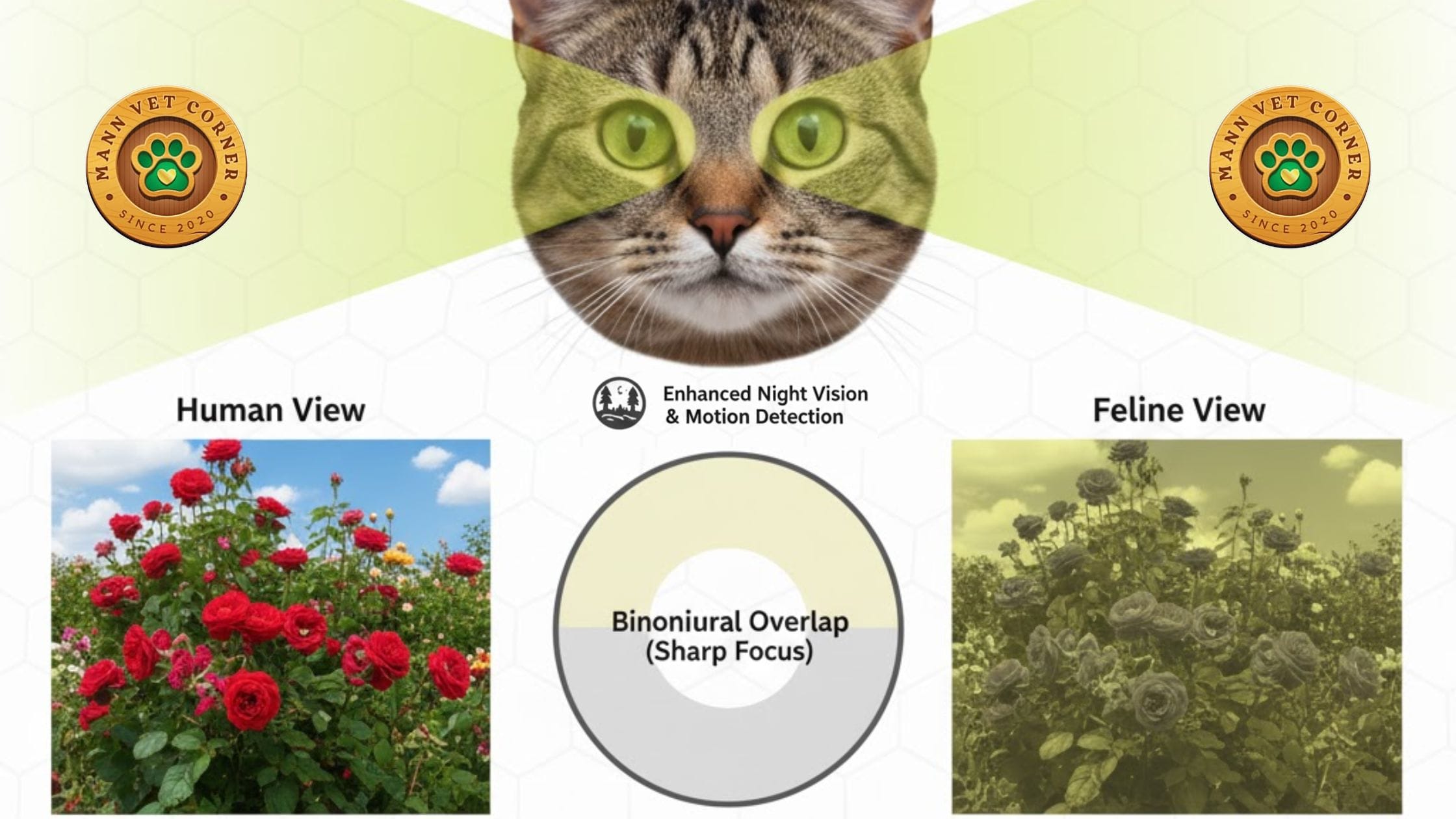Understanding Cat Vision and Colors
Cat eyes are among nature’s most fascinating adaptations, perfectly engineered for survival and hunting. Have you ever wondered why your cat’s eyes seem to glow eerily in the dark, or how they can spot a tiny insect moving across the room that you barely notice? The secret lies in the extraordinary design of cat eyes, one of evolution’s most impressive achievements in the animal kingdom.
Cat eyes represent millions of years of evolutionary perfection, specifically adapted foca r a predator’s lifestyle. Unlike human eyes that are optimized for daytime color vision and detailed focus, feline eyes are masterfully engineered for low-light hunting, rapid motion detection, and exceptional peripheral awareness. From the mysterious glowing effect you see in photographs to their ability to navigate confidently through near-darkness, every aspect of cat vision serves a precise survival purpose.
As a cat owner, understanding how your feline companion perceives the world isn’t just fascinating, it’s essential for providing better care and recognizing potential health issues early. Whether your cat displays dilated pupils during playtime, develops unusual eye discharge, or you’re simply curious about what colors cats can actually see, this comprehensive guide will illuminate the remarkable world of cat eyes. You’ll discover the science behind their supernatural night vision, learn to interpret what different pupil sizes mean, and gain practical knowledge about maintaining your cat’s eye health for years to come.
How Cat Eyes Work: The Science Behind Feline Vision
Cat eyes function differently from human eyes in several remarkable ways. These specialized structures have evolved over millions of years to create one of the most efficient visual systems in the animal kingdom.
The Tapetum Lucidum: Nature’s Night Vision Technology
The tapetum lucidum is perhaps the most distinctive feature of cat eyes. This reflective layer sits behind the retina and acts like a biological mirror, bouncing light back through the retina for a second chance at detection. This ingenious adaptation is why cats’ eyes appear to glow when illuminated in the dark—you’re actually seeing light reflected back from this specialized layer.
This reflective tissue contains zinc and protein crystals that amplify available light by up to 40%, giving cats exceptional night vision capabilities. While humans struggle to see in dim conditions, cats can navigate confidently with just one-sixth of the light humans need. This evolutionary advantage made cats formidable nocturnal hunters, allowing them to pursue prey during dawn, dusk, and nighttime hours when many small mammals are most active.
Vertical Slit Pupils: Adaptive Light Control
Cat eyes feature distinctive vertical slit pupils that can expand and contract dramatically depending on light conditions. In bright sunlight, these pupils narrow to thin vertical lines, protecting the sensitive retina from overexposure. In darkness, they dilate to nearly circular shapes, maximizing light entry and enhancing vision.
This vertical orientation provides cats with superior depth perception and distance judgment—critical skills for ambush predators who must accurately gauge the distance to their prey before pouncing. The slit shape also allows for faster and more precise control over light entry compared to the round pupils found in humans.
Research suggests that vertical pupils are particularly common in ambush predators that are active both day and night, while animals with round pupils tend to be either exclusively diurnal or nocturnal. This adaptation perfectly matches the cat’s lifestyle as a crepuscular hunter.
Cat Eye Anatomy: Understanding the Structure
The anatomy of cat eyes reveals multiple specialized features that work together to create their superior visual capabilities.
The Retina and Photoreceptor Distribution
Cat eyes contain a higher concentration of rod cells compared to cone cells in their retinas. Rod cells are responsible for detecting motion and seeing in low light, while cone cells enable color vision. This distribution prioritizes motion detection and night vision over color perception—exactly what a predator needs.
The retina in cat eyes also features a horizontal visual streak, an area of enhanced photoreceptor density that provides sharper vision across the horizontal plane. This adaptation helps cats scan their environment for prey moving along the ground.
The Nictitating Membrane: The Third Eyelid
Cats possess a nictitating membrane, commonly called the third eyelid, which is a thin, translucent tissue that sweeps horizontally across the eye. This membrane serves multiple protective functions:
- Removes debris and foreign particles from the eye surface
- Distributes tear film to keep eyes moist and healthy
- Provides additional protection during hunting and fighting
- Can partially cover the eye when a cat is unwell, stressed, or sleeping
While you might occasionally glimpse this membrane when your cat is drowsy or just waking up, persistent visibility of the third eyelid can indicate health problems requiring veterinary attention.
Cornea and Lens Adaptations
Cat eyes have a proportionally larger cornea and lens compared to humans, allowing more light to reach the retina. The cornea is also more curved, providing a wider field of view and better light-gathering ability. These structural modifications work in concert with other adaptations to maximize visual performance in challenging lighting conditions.
Cat Vision Range: Field of View and Visual Abilities
Understanding what cats can actually see helps explain their behavior and hunting strategies.
Peripheral Vision and Motion Detection
Cats boast an impressive field of vision of approximately 200 degrees, compared to humans’ 180 degrees. This wider visual range gives cats superior peripheral vision, allowing them to detect movement at the edges of their visual field—a crucial advantage when watching for prey or predators.
However, cats sacrifice some visual acuity for this wider view. While humans excel at seeing fine details directly ahead, cats are optimized for detecting motion across a broad visual field. Their eyes are positioned more toward the front of their heads than many prey animals, providing significant binocular overlap (approximately 140 degrees) that enhances depth perception for hunting.
Visual Acuity: What Cats See Clearly
Cat eyes have visual acuity of about 20/100 to 20/200, meaning they see at 20 feet what humans with normal vision see at 100-200 feet. While this seems inferior, it’s perfectly suited to their needs as hunters of small, nearby prey rather than distant targets.
Cats see most clearly at distances of 2-6 meters (6-20 feet)—precisely the range at which they launch hunting attacks. Beyond 6 meters, their vision becomes increasingly blurry, while very close objects (within a few inches) are also difficult for them to focus on clearly.
Nearsighted vs. Farsighted Cat Eyes
Most cats are naturally slightly nearsighted, an adaptation that serves their hunting style. They don’t need to spot prey from great distances; instead, they rely on their exceptional hearing and sense of smell to locate potential meals, then use their vision for the final approach and attack.
Cat Eye Colors: Genetics and Variations
Cat eye color is determined by melanin pigmentation in the iris and is independent of coat color, though certain associations exist.
Common Cat Eye Colors
The spectrum of cat eye colors includes:
- Green: Ranging from pale jade to deep emerald
- Yellow/Gold: From pale yellow to rich amber
- Blue: Common in white cats and certain breeds like Siamese
- Copper/Orange: Deep reddish-orange hues
- Odd-eyed: Two different colored eyes, often one blue and one green or gold
Kitten Eye Color Development
All kittens are born with blue eyes due to the absence of pigment in the iris. As they mature, melanocytes begin producing melanin, and the adult eye color develops between 6-8 weeks of age, with the final color typically established by 3-4 months.
White Cats with Blue Eyes and Deafness
White cats with blue eyes have a higher incidence of congenital deafness due to the degeneration of the inner ear structures. This genetic link occurs because the same gene responsible for white coat color and blue eyes can also affect hearing development. Interestingly, white cats with one blue eye may be deaf only in the ear on the same side as the blue eye.
Cat Color Vision: What Colors Can Cats See?
The question of whether cats see in color has fascinated researchers for decades.
Limited Color Perception
Cat eyes contain two types of cone cells, allowing them to perceive colors in the blue-violet and yellow-green spectrum. This dichromatic vision is similar to that of humans with red-green color blindness. Cats can distinguish between blues and greens but have difficulty differentiating reds, pinks, and oranges, which may appear more grayish or greenish to them.
This limited color vision isn’t a disadvantage for cats. Since they hunt primarily at dawn and dusk when light is dim, the ability to detect motion and see in low light is far more valuable than distinguishing between various colors.
Comparison to Human Color Vision
Humans are trichromats, possessing three types of cone cells that enable us to see a full spectrum of colors. Cats’ dichromatic vision means they experience a more muted color palette. However, their superior night vision and motion detection more than compensate for this limitation in their natural lifestyle.
Cat Night Vision: Seeing in the Dark
The legendary ability of cats to see in darkness is based on multiple anatomical adaptations working together.
How Cats See in Low Light
Cat eyes can function effectively in light levels six times lower than humans require. This remarkable capability comes from:
- The tapetum lucidum reflecting light for enhanced photon capture
- Large pupils that dilate extensively in darkness
- High concentration of rod photoreceptors for low-light sensitivity
- Large corneas and lenses that gather more available light
These adaptations make cats crepuscular hunters and most active during twilight hours when their visual advantages are maximized and their prey is also active. Cats have 6 to 8 times more rod cells in their retinas compared to humans, which allows them to see well in low-light conditions. This adaptation is crucial for their crepuscular hunting habits, as they are most active during dawn and dusk.
Limitations of Cat Night Vision
Despite their impressive low-light capabilities, cats cannot see in complete darkness. They still require some ambient light for vision to function. In absolute darkness, cats rely more heavily on their other enhanced senses, particularly hearing and their sensitive whiskers (vibrissae), which detect air currents and help them navigate.
Frequently Asked Questions About Cat Eyes
Can cats see in complete darkness?
No, cats cannot see in complete darkness. They have exceptional night vision and can see in light levels six times lower than humans require. However, they still need some ambient light for their eyes to function. In total darkness, cats rely on their other highly developed senses. These include hearing and their sensitive whiskers to navigate their environment.
Why do cat eyes glow in the dark?
Cat eyes appear to glow when light hits them because of the tapetum lucidum. This is a reflective layer behind the retina. This biological mirror bounces light back through the retina. It gives photoreceptors a second chance to detect it. The “glow” you see is actually light being reflected back out of the eye. This adaptation helps cats see better in low-light conditions.
Are all white cats with blue eyes deaf?
Not all white cats with blue eyes are deaf. However, they have a significantly higher incidence of congenital deafness. The gene responsible for white coat color and blue eyes can also affect inner ear development. White cats with one blue eye may be deaf only on the same side as the blue eye. The other ear often functions normally.
What colors can cats actually see?
Cats have dichromatic vision. This means they can see colors in the blue-violet and yellow-green spectrum. This is similar to human red-green color blindness. Cats can distinguish between blues and greens. They have difficulty seeing reds, pinks, and oranges. These colors may appear grayish or greenish to them. Their limited color vision doesn’t hinder them. They rely more on motion detection and night vision for hunting.
Why do cats have slit-shaped pupils?
Vertical slit pupils serve multiple important functions. They can expand and contract dramatically to control light entry. In bright light, they narrow to thin lines to protect the retina. In darkness, they dilate to nearly circular shapes to maximize light capture. This shape also provides superior depth perception and distance judgment. These abilities are essential for ambush predators who must accurately gauge distance before pouncing.
Can cats see better than humans?
Cats and humans have different visual strengths suited to their lifestyles. Cats excel at night vision, motion detection, and peripheral vision. They have a 200-degree field of view compared to humans’ 180 degrees. However, humans have superior visual acuity and color perception. Cats have vision of about 20/100 to 20/200. This means they see at 20 feet what humans see at 100-200 feet. Each species’ vision is optimized for their survival needs.
What is the third eyelid in cats?
The third eyelid, or nictitating membrane, is a thin, translucent tissue. It sweeps horizontally across a cat’s eye and serves protective functions including removing debris and distributing tears to keep eyes moist. It also provides protection during hunting or fighting. You might occasionally see it when your cat is drowsy or waking up. Persistent visibility can indicate health problems requiring veterinary attention.
At what distance do cats see best?
Cats see most clearly at distances of 2-6 meters (approximately 6-20 feet). This is precisely the range at which they typically launch hunting attacks. Beyond 6 meters, their vision becomes increasingly blurry. Very close objects within a few inches are also difficult for them to focus on. This visual range is perfectly adapted to their hunting strategy as ambush predators.
When do kittens develop their adult eye color?
All kittens are born with blue eyes. This is due to the absence of pigment in the iris. As they mature, specialized cells called melanocytes begin producing melanin. The adult eye color starts developing between 6-8 weeks of age. The final, permanent eye color is typically established by 3-4 months of age.
Are cats nearsighted or farsighted?
Most cats are naturally slightly nearsighted. This is an adaptation suited to their hunting style. They don’t need to spot prey from great distances. Instead, cats rely on their exceptional hearing and sense of smell to locate potential prey from afar. Then they use their vision for the final approach and precise attack at closer range.
Conclusion
Cat eyes represent one of nature’s most elegant solutions to the challenges of survival as a predator. Through millions of years of evolution, these remarkable organs have developed specialized adaptations. The light-amplifying tapetum lucidum and precision-engineered vertical slit pupils work in harmony. Together they create a visual system perfectly tuned for hunting in low light conditions.
Cat eyes may not see the world exactly as we do. They have limited color perception and reduced visual acuity compared to humans. But they possess abilities that far surpass our own in the conditions that matter most to feline survival. They can detect the slightest movements across a wide field of view and navigate confidently in near-darkness with just a fraction of the light we need. They accurately judge distances for the perfect pounce. This demonstrates that vision is not one-size-fits-all. Rather, it’s an expression of each species’ unique ecological niche.
Understanding how cat eyes work satisfies our curiosity about these fascinating creatures. It also helps us become better caretakers. Recognizing what cats can and cannot see influences how we design their environments. It affects how we choose their toys and interpret their behaviors. Whether you’re watching your cat track an invisible speck across the floor with laser focus or marveling at their confident navigation through a darkened room, you’re witnessing evolutionary refinement. This has made cats one of nature’s most successful predators.
The next time you catch the ethereal glow of your cat’s eyes in a darkened room, take a moment to appreciate it. Notice those distinctive vertical pupils narrowing in bright sunlight. You’ll appreciate the sophisticated biological engineering at work. Cat eyes are not just windows to their souls. They’re masterpieces of natural design that continue to captivate and intrigue. They remind us of the incredible diversity and ingenuity of life on Earth.






